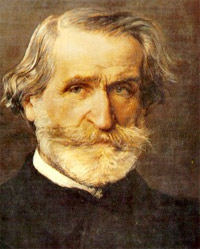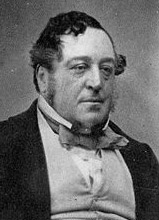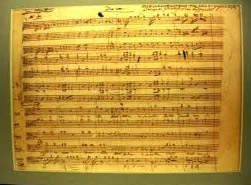Verdi in Hartford: That Old-Time Religion
I recently attended an extraordinary performance of Verdi’s Requiem, at St. Joseph’s Cathedral, in Hartford, Connecticut.
Hartford is a small but artistically distinguished city about halfway between New York and Boston. It is the site, for example, of the Hartt School, an internationally renowned conservatory, teaching music, dance, and theatre.
(The word “Hartt” in the name of the school has two “t”s, not one, because it is named after one of the founders, Julius Hartt, not after the city itself!)
St. Joseph’s Cathedral, right in the center of Hartford, (near the tourist-trap Mark Twain House), is itself an impressive structure built fifty years ago, entirely of concrete so as never to be threatened by fire. Indeed, the Verdi Requiem was scheduled for the evening of March 16, 2012, in celebration of the 50th anniversary of this structure.

Giuseppe Verdi
The performers included 400 singers in various choirs (the Hartford Chorale, the Cathedral Choral, the Hartt Choir, etc.), 85 instrumentalists, four wonderful soloists, and as conductor, one should say perhaps as the Maestro, Edward Bolkovac.
The four soloists were: soprano Amanda Hall; mezzo-soprano Lucille Beer; tenor Raffaele Sepe; and bass Ryan Green. For reasons I don’t understand, I find that somebody has posted a YouTube clip of the same Lucille Beer singing on a polo ground. The setting is bizarre, but you will likely enjoy the singing.
The tenor is also available on YouTube, apparently a clip from a television talent show. The clip is a fun listen, although you’ll have to skip to about the 1:40 part on that clip if you want to avoid the inane introductory chit-chat of the TV host.
Since Thomas of Celano’s Day
But let’s say a few words about the tradition of the Requiem itself. A Requiem Mass for the repose of one or more newly departed persons is a very old rite within the Roman Catholic Church, and had taken the form in which Verdi found it as early as the 13th century, when Thomas of Celano, a follower of St Francis of Assisi, wrote the hymn “Dies Irae.”
Thomas’ hymn begins thus:
Dies iræ! Dies illa
Solvet sæclum in favilla:
Teste David cum Sibylla!
Quantus tremor est futurus,
Quando iudex est venturus,
Cuncta stricte discussurus!
Tuba mirum spargens sonum
Per sepulchra regionum,
Coget omnes ante thronum.
In straightforward unversified English, that is: “The day of wrath! That day will dissolve the world into ashes; As David foretold, and the Sibyll! How much trembling there will be when the judge arrives, and investigates everything strictly! The trumpet will spread a wondrous sound through the burial vaults of the regions, and will summon all before the throne.”
Musical settings of the Requiem Mass became a distinctive musical genre – often performed in concert halls and thus at least topographically separated from the initial purpose of the music – by the mid 16th century. One of the great composers of that era, Palestrina, set it this way.
Mozart, Berlioz, Liszt
Between Palestrina and Verdi, the outstanding Requiems came from Mozart (1791), Berlioz (1837) and Liszt (1867). Something of a music-history “A Team” there!
Of Mozart’s Requiem there is little to be said that hasn’t been said abundantly over the centuries.
Here, though, is a bit of Hector Berlioz’ Requiem (also known as the Messe des morts), not quite so well known as Mozart’s, but just as beloved by those who have known it. This was composed as a Mass for those soldiers who had died during the Revolution of July 1830. Specifically, I present you with Berlioz’ Dies iræ.
There’s an amusing story in connection with the premiere of the Messe des morts. The conductor, Francois Antoine Habeneck, put his baton down in mid-performance in order to take a pinch of snuff! Berlioz was there, and was understandably furious. As he says in his memoir, this was “the one bar where the conductor’s direction is absolutely indispensable”! It came about during the Tuba mirum passage quoted above.
Berlioz leapt up, took a position between Habeneck and the orchestra, and started conducting by himself. I hope Habeneck enjoyed the snuff, because he didn’t get the orchestra back – Berlioz continued this way through the rest of the performance, “and the effect which I had dreamed of was produced,” he reports.

Franz Liszt
Franz Liszt’s Requiem of 1867 is historically remarkable because nobody seems to know whose death inspired it. It might have been composed as a lament for the Emperor Maximilian, the unlucky fellow who became Emperor of Mexico with the backing of French Emperor Napoleon III and who was captured and executed by the forces of Benito Juarez in 1867. That’s possible. But the uncertainty on this subject shows that it was no longer all that important: by this time the Requiem as a musical genre has detached itself from its origins: it was still a Mass in form, not necessarily in motivation.
On to Verdi
So we return to Giuseppe Verdi, one of the towering musical figures in the history of the music-mad Italian peninsula. Verdi first began contemplating the Requiem form at the end of 1868, with news of the death of his colleague, Gioachino Rossini (the composer of The Barber of Seville, Otello, and La Cenerentola, among much else)

Gioachino Rossini
Verdi and Rossini had never been friends, and their musical styles are very different, but Verdi of all people understood the depth of the loss. “A great name has disappeared from the world!” he said.
So Verdi set out to organize the outstanding Italian composers of the day in a collaborative effort to create a Requiem worthy of Rossini. Verdi’s own contribution to this joint effort was to be the final movement, Libera me.
The project never came to fruition, and Verdi was left with his Libera me sitting in his desk. Yet since death is the one inevitability in life, it was certain that – if Verdi himself only lived to see it – there would come another death that would affect him sufficiently that he would take up his pen again and write a complete Requiem with that fragment as a point of departure.
That day came with the death of Alessandro Manzoni in May 1873. Verdi’s Requiem was firm performed a year later, in the Church of San Marco in Milan. Verdi himself conducted, thus avoiding any snuff-based threats to its perfection.
Since Vatican II
One sad theological point, though, is that the Roman Church no longer holds the old style Masses for the Dead, with the various hymns that have inspired so many great conductors through the centuries. This all fell victim to the Second Vatican Council’s ecclesiastical reforms. The new “Rite of Funerals,” issued in 1969, does away with black vestments and with words that focus on trembling or ashes. Instead, we are to see death as a hopeful event, a step into a better world for the deceased.
All quite comforting in a sense: but that sense is not musical. The new Rite of Funerals has yet to produce anything analogous to the masterpieces composed on behalf of that Old Time Religion!
In closing, I’m afraid I have to admit that I can’t give you a link to any recording of the performance in Hartford. Perhaps you will accept the following, with my best wishes, pending




Elizabeth said:
Mar 29, 12 at 21:19There is a wonderful YouTube video Michael recommended of the Dies Irae being conducted by the great Arturo Toscannini himself. Remarkable because Toscanini knew and spoke with Verdi on a semi regular basis. The conductor can be heard shouting at the trumpets to play louder and louder.
http://www.youtube.com/watch?v=jDbMzp86tOc